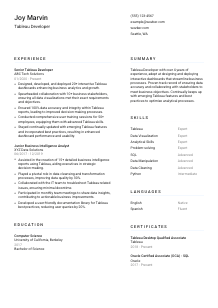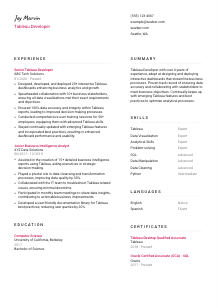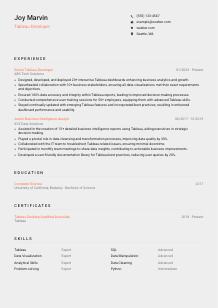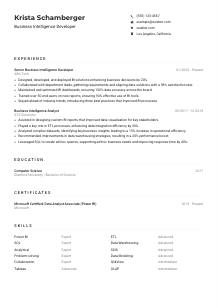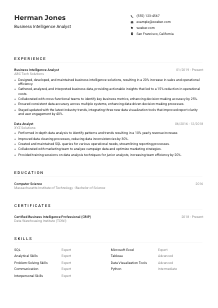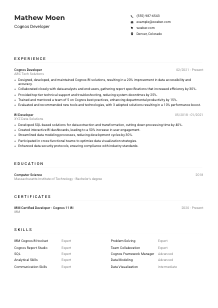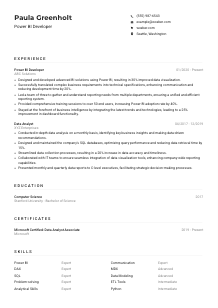Tableau Developer Resume Example
Visualizing data, but your resume looks like raw numbers? Dive into this Tableau Developer resume example, designed with Wozber free resume builder. Grasp how effortlessly you can blend your visualization wizardry with job prerequisites, ensuring your career story is as crisp and vibrant as your dashboards!
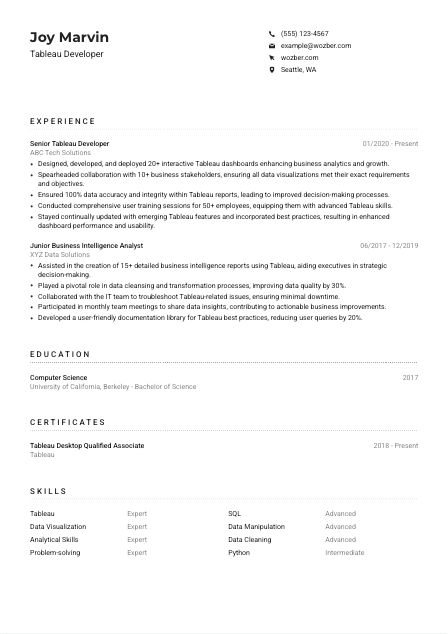
How to write a Tableau Developer resume?
Embarking on your quest to land the Tableau Developer role you've been eyeing? The battlefield is fierce, but fear not! Your resume is your mightiest weapon, and with Wozber's free resume builder at your side, you're already one step ahead.
This guide isn't just about building a resume; it's about constructing a bridge to your dream job, optimizing it for ATS, and making sure your unique skills in data visualization and Tableau shine through. Let's start this journey together and make your resume not just a document, but a testament to your Tableau prowess.
Personal Details
The 'Personal Details' section is your resume's handshake. It's your first opportunity to introduce yourself, so let's make sure it's more memorable than a data blip in a vast sea of numbers. Here are the steps to sculpt this section to resonate with the Tableau Developer role.
1. Name: Your Brand's Headline
Consider your name the title of your professional story. Use a clear, professional font that stands out, ensuring your name captures immediate attention, setting a commanding presence from the get-go.
2. Job Title Alignment
Directly beneath your name, lock in your targeted role: ‘Tableau Developer'. This aligns your resume to the job at a glance and paints you as a specialist, not just another applicant.
3. Key Contact Info
"Phone Number": Double-check this. A typo here could mean a missed opportunity. "Professional Email Address": Keep it simple and professional, e.g., firstname.lastname@email.com. Ensuring this matches the professionalism of your chosen field sets the right tone.
4. Location Match
Mentioning "Seattle, WA" highlights your alignment with the job's geographic requirement, subtly assuring there are no relocation delays to contend with.
5. Professional Profiles
Including a LinkedIn profile or personal website dedicated to your Tableau projects or portfolio can provide a dynamic layer to your application, showcasing your skills beyond the resume.
Takeaway
Think of the 'Personal Details' section as the doorway to your professional narrative. Craft each element with intention, setting the stage for an impactful first impression. Keep it neat, precise, and aligned with the Tableau Developer role you're eyeing.





Experience
The 'Experience' section is where you get to showcase your Tableau triumphs. Here, you'll translate your work history into a compelling story of growth, impact, and proficiency. Let's dive into making each point a testament to your suitability for the Tableau Developer role.
- Designed, developed, and deployed 20+ interactive Tableau dashboards enhancing business analytics and growth.
- Spearheaded collaboration with 10+ business stakeholders, ensuring all data visualizations met their exact requirements and objectives.
- Ensured 100% data accuracy and integrity within Tableau reports, leading to improved decision‑making processes.
- Conducted comprehensive user training sessions for 50+ employees, equipping them with advanced Tableau skills.
- Stayed continually updated with emerging Tableau features and incorporated best practices, resulting in enhanced dashboard performance and usability.
- Assisted in the creation of 15+ detailed business intelligence reports using Tableau, aiding executives in strategic decision‑making.
- Played a pivotal role in data cleansing and transformation processes, improving data quality by 30%.
- Collaborated with the IT team to troubleshoot Tableau‑related issues, ensuring minimal downtime.
- Participated in monthly team meetings to share data insights, contributing to actionable business improvements.
- Developed a user‑friendly documentation library for Tableau best practices, reducing user queries by 20%.
1. Job Requirements Breakdown
Scour the job posting for key responsibilities and required skills. This will serve as your checklist when detailing your past roles, directly linking your experiences to what the employer is looking for.
2. Present with Precision
Organize your experiences in a reverse-chronological format, starting with your most recent role. For each position, list your title, the company, and your tenure, creating a clear timeline of your career trajectory.
3. Crafting Achievements
Detail significant achievements in previous roles, directly mirroring the responsibilities and desired skills of the Tableau Developer position. For instance, "Designed, developed, and deployed 20+ interactive Tableau dashboards" directly addresses a key job responsibility.
4. Quantitative Impact
Wherever possible, quantify your accomplishments. Numbers make your contributions tangible, whether it's the number of dashboards created, the percentage improvement in data accuracy, or the number of users trained.
5. Relevance is Key
Focus solely on experiences that showcase your Tableau development skills and analytical prowess. Each point should serve as a stepping stone, building up to why you're the ideal candidate for this role.
Takeaway
Your experience section is your portfolio within your resume. It's where you showcase not just that you've been there and done that, but that you've excelled and left a mark. By aligning your experiences with the Tableau Developer role, you're speaking the employer's language before even meeting them.
Education
While your skills and experience take the forefront, your education section reinforces your foundational knowledge. Tailoring this section to reflect both your qualifications and the job's requirements adds another layer of compatibility between you and your dream role.
1. Pinpointing Educational Must-Haves
Identify the educational qualifications sought in the job posting – in this case, a Bachelor's degree in Computer Science or related field. This information sets the baseline for what to include.
2. Simple and Straightforward
Maintain clarity and brevity while listing your education details. Include your degree, major, the institution, and graduation date. A well-organized education section reassures employers of your credentials.
3. Aligning Your Degree
If your degree directly aligns with the job requirements, highlight it prominently. Our Tableau Developer example included a "Bachelor of Science in Computer Science," perfectly matching the employer's criteria.
4. Coursework and Specializations
If relevant, mentioning specific courses or projects related to data visualization or Tableau can provide a deeper insight into your preparedness for the role, especially valuable if you're at the early stages of your career.
5. Additional Achievements
Should you have graduated with honors or participated in clubs or projects pertinent to the Tableau field, include these details. They add depth to your educational background and signal a genuine interest in your profession.
Takeaway
The education section is a testament to your academic commitment and a nod to your readiness for the Tableau Developer position. It's an essential piece of your story, validating your knowledge base and setting you apart as a well-rounded candidate.
Certificates
In the world of Tableau and data visualization, certifications can significantly bolster your credentials. They are a testament to your dedication to professional development and mastery of specific skills. Let's optimize this section to make your resume even more compelling.
1. Highlight Pertinent Certifications
Start with certifications directly relevant to the Tableau Developer position, such as the "Tableau Desktop Qualified Associate" certification mentioned in the job description. This displays your commitment to the Tableau platform.
2. Selective Inclusion
Focus on including certifications that enhance your candidacy for the Tableau Developer role. Quality trumps quantity, ensuring that what you list improves your standing as a prime candidate.
3. Dates Matter
Adding the date of certification (e.g., "2018 - Present") signals to employers the currency of your knowledge and skills, an important aspect in a quickly evolving field like Tableau development.
4. Continuous Learning
Show a commitment to staying up-to-date with the latest Tableau features and best practices. It's a signal to potential employers that you're not just proficient but also continually advancing your skill set.
Takeaway
Your certifications are powerful indicators of your expertise and initiative. By carefully selecting which ones to include, you signal to employers your dedication to the craft and readiness to contribute to their success.
Skills
Your 'Skills' section is a curated showcase of your professional toolkit. When applied strategically, this section can quickly signal your fit for the Tableau Developer role to hiring managers. Let's ensure your skills are displayed with the precision and clarity they deserve.
1. Decode and Match
Extract key skills directly from the job description and match them with your own set. For instance, skills like "Data Visualization", "SQL", and "Analytical Skills" are explicitly sought after for the Tableau Developer role.
2. Prioritize and Organize
List your skills in a way that prioritizes those most relevant to the Tableau Developer position. This isn't just about listing what you can do; it's about highlighting your prowess in areas that matter most to the role.
3. Clean Presentation
Resist the urge to include every skill you've ever acquired. Instead, focus on those that resonate most with the job at hand. A cluttered skills section can dilute the impact of your true strengths.
Takeaway
Approach your skills section as a promise of the value you bring to the Tableau Developer role. By curating this list to reflect the job's demands, you ensure that every line on your resume works in your favor, vividly portraying you as the ideal candidate.
Languages
In today's connected world, multilingualism can be a key differentiator. While the Tableau Developer position emphasizes English proficiency, showcasing additional language skills can provide a competitive edge. Let's articulate this section to highlight your linguistic dexterity.
1. Job Language Specification
Since the job description calls for "English language efficiency," listing English with a proficiency rating of 'Native' or 'Fluent' meets this requirement directly. This clear alignment with job specifications is crucial.
2. Showcase Additional Languages
If you're proficient in other languages, list them to showcase your ability to work in a diverse, multicultural environment. This can be particularly advantageous for roles involving cross-border teams or clients.
3. Honesty in Proficiency
Be clear and honest about your language proficiency levels. Misrepresenting your ability could lead to challenges down the line. A straightforward portrayal of your linguistic capabilities builds trust.
4. Relevance to the Role
Assess whether your language skills have a direct impact on your ability to perform in the Tableau Developer role. For roles with a global or multicultural aspect, your linguistic abilities can add significant value.
5. Continuous Improvement
Even if not immediately relevant, showing that you are working on improving your language skills can illustrate a dedication to personal growth and adaptability, qualities valued in any role.
Takeaway
Your language skills can denote more than just the ability to converse in another dialect. They can reflect cultural awareness, adaptability, and a global mindset – attributes that are increasingly valuable in today's interconnected world. Showcase them proudly.
Summary
Your summary is the opening narrative of your professional story. It's your chance to captivate, in just a few lines, why you are the remarkable candidate for the Tableau Developer position. Let's craft a summary that's as engaging and dynamic as the dashboards you're passionate about creating.
1. Grasp the Job's Essence
Start with a deep understanding of what the Tableau Developer role entails. Absorb the job description, focusing on core responsibilities and required skills, to craft a summary that hits all the right notes.
2. Compelling Introduction
Begin with a confident statement about your professional identity – "Tableau Developer with over 4 years of experience" immediately places you as an experienced candidate while aligning with the job's requirements.
3. Concise Skill Highlights
Briefly touch on skills and achievements that resonate with the job. For example, emphasizing your proficiency in Tableau and analytical skills showcases your direct fit for the role.
4. The Art of Brevity
Keep your summary succinct. Aim for 3-5 sentences that encapsulate your experience, skills, and the unique value you bring to the Tableau Developer position.
Takeaway
Consider your summary the handshake that turns heads. It's your chance to assert, right at the outset, that you're not just another candidate – you're the Tableau Developer they've been searching for. Craft it with care, and let it set the tone for the rest of your resume.
Embarking on Your Tableau Developer Journey
With these tailored steps, you're now ready to build a resume that doesn't just list your experiences and skills but tells your professional story with purpose and conviction. Remember, every section of your resume is an opportunity to demonstrate your fit for the Tableau Developer role. Use Wozber's free resume builder, including the ATS-friendly resume template for design and ATS resume scanner for keyword optimization, to ensure your resume not only meets the requirements but stands out.
Empower your job search with a resume that captures your essence and expertise. The world awaits your analytical acumen and data visualization mastery – go forth and seize your dream role!

- Bachelor's degree in Computer Science, Information Systems, or related field.
- Minimum of 3 years of experience in Tableau development and data visualization.
- Proficiency in SQL for data querying and manipulation.
- Strong analytical and problem-solving skills.
- Tableau Desktop Qualified Associate certification or equivalent.
- English language efficiency is a requirement.
- Must be located in Seattle, WA.
- Design, develop, and deploy interactive Tableau dashboards to support business needs.
- Collaborate with business stakeholders to gather requirements and ensure data visualizations meet their needs.
- Ensure data accuracy and integrity within Tableau reports and dashboards.
- Conduct user training and provide ongoing support to Tableau end-users.
- Stay updated with the latest Tableau features and best practices to ensure optimal performance and usability.





